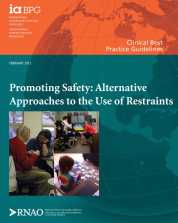The purpose of this best practice guideline (BPG) is to provide evidence-based recommendations for registered nurses (RNs) and registered practical nurses (RPNs) related to the care of individuals who are at risk for behaviours that may result in harm to self/others and lead to the possible use of restraints (physical, chemical, environmental). Unless otherwise indicated in the guideline, the discussion focus is on physical restraint.
The purpose of this best practice guideline (BPG) is to provide nurses and the interprofessional team with evidence-based recommendations for the most effective strategies to support adults (18 years and older) who anticipate or live with an ostomy that will:
(a) promote self-management,
(b) enhance access and delivery of care, and
(c) lead to positive health outcomes.
The purpose of this best practice guideline (BPG) is to provide nurses (nurse practitioners, registered nurses, registered practical nurses and nursing students) and other members of the interprofessional team with evidence-based recommendations and resources related to the insertion, assessment and maintenance of vascular access devices (VADs) in the infant (0–1 year), pediatric (1–18 years) and adult populations (18 years and older).

